At Last Autumn is here
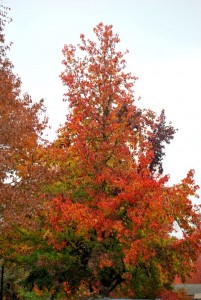 Autumn is here. Autumn is magic. One day Everything dissolves into fire and light and then disappears into the wind and rain the next. Leaving only the most tenacious waiting for the next storm to finish the job. To me the light is often more intense then a clear sunny August day. On a tr
Autumn is here. Autumn is magic. One day Everything dissolves into fire and light and then disappears into the wind and rain the next. Leaving only the most tenacious waiting for the next storm to finish the job. To me the light is often more intense then a clear sunny August day. On a tr ip to Sisters-and, yes that is the name of a town not a trip to siblings- and over the Santiam Pass the colours were so intense often reflected against a deep green of the ever greens or from areas gone grey and then green from past forest fires. By the time we came home, i felt that my eyes had been burned out and needed to rest in a dark room for a week. Every time I closed my eyes I was left with and after burn/ after image of the opposite colour. An interesting phenomena that happens when one stares at a given colour too long. You perceive it’s opposite on the colour wheel.(see box below for a real scientific explanation that isn’t based on emotion) I want to memorialize the colours and use them in a tapestry mixing them into incredible Chene’s and mélanges-bobbin blending at it’s best…
ip to Sisters-and, yes that is the name of a town not a trip to siblings- and over the Santiam Pass the colours were so intense often reflected against a deep green of the ever greens or from areas gone grey and then green from past forest fires. By the time we came home, i felt that my eyes had been burned out and needed to rest in a dark room for a week. Every time I closed my eyes I was left with and after burn/ after image of the opposite colour. An interesting phenomena that happens when one stares at a given colour too long. You perceive it’s opposite on the colour wheel.(see box below for a real scientific explanation that isn’t based on emotion) I want to memorialize the colours and use them in a tapestry mixing them into incredible Chene’s and mélanges-bobbin blending at it’s best… 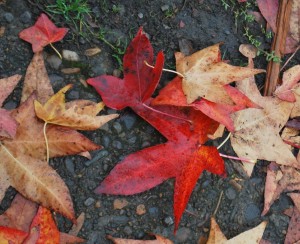 There is a particular red that i have been trying to achieve for what seems like a million years. A cool red that darkens into a a deep
There is a particular red that i have been trying to achieve for what seems like a million years. A cool red that darkens into a a deep 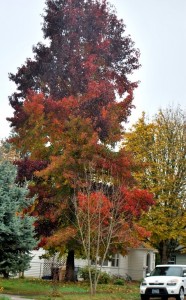 maroon or purple with a hint of a Deep turquoise green and a hint of salmon.
maroon or purple with a hint of a Deep turquoise green and a hint of salmon.
Actually, who am I kidding there is also a salmon colour that dissolves to yellow-green. I haven’t been able to capture.And, the list goes on to several other almost unrepeatable colours. I have more luck i think with the optical blending using bobbin blends then a dyer has trying to create the colours in dying the yarns for my wefts. My bobbin blends don’t turn to muddy colours like some dyes do when trying to copy these colours. Should try to be less smug about it, but optical blending on a bobbin is pretty cool.
| THE WHY OF IT. Negative afterimages are caused when the eye’s photoreceptors, primarily those known as cone cells, adapt from the overstimulation and lose sensitivity.[1] Normally, the eye deals with this problem by rapidly moving small amounts (see: microsaccade), the motion later being “filtered out” so it is not noticeable. However, if the color image is large enough that the small movements are not enough to change the color under one area of the retina, those cones will eventually tire or adapt and stop responding. The rod cells can also be affected by this. When the eyes are then diverted to a blank space, the adapted photoreceptors send out a weak signal and those colors remain muted. However, the surrounding cones that were not being excited by that color are still “fresh”, and send out a strong signal. The signal is exactly the same as if looking at the opposite color, which is how the brain interprets it.[citation needed] Swiped from Wikipedia |
Working on clarity and specifics- It was time to journal again and create goals.
I am at a time in my life like no other. So, Pat and I spent a couple of days at the coast along with Chene. Whose only concerned was and where is next treat was coming from and with not getting his feet and belly wet needlessly. After all it is Autumn at the coast. Some times distance and solitude are needed to put things into proper or even a new light and a time to figure out what is dross and should be allowed to fall away. It’ was also a time of getting away from the clutter that has occurred mentally over the last year and to define a new mental space when the old rules and things are no longer applicable because life has radically altered for me-once again.
at a time in my life like no other. So, Pat and I spent a couple of days at the coast along with Chene. Whose only concerned was and where is next treat was coming from and with not getting his feet and belly wet needlessly. After all it is Autumn at the coast. Some times distance and solitude are needed to put things into proper or even a new light and a time to figure out what is dross and should be allowed to fall away. It’ was also a time of getting away from the clutter that has occurred mentally over the last year and to define a new mental space when the old rules and things are no longer applicable because life has radically altered for me-once again. 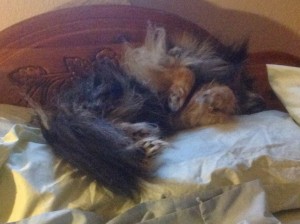 It was a good time to revamp and create a new workable schedule-My weaving time was always disappearing as I worked down lists of relevant needful things to do that were eating in to my non scheduled weaving times. Give me list and I’ll work it through until it’s finished no matter what I really want to do. So, Monday is silver, Tuesday is Fine Fiber Press book wo
It was a good time to revamp and create a new workable schedule-My weaving time was always disappearing as I worked down lists of relevant needful things to do that were eating in to my non scheduled weaving times. Give me list and I’ll work it through until it’s finished no matter what I really want to do. So, Monday is silver, Tuesday is Fine Fiber Press book wo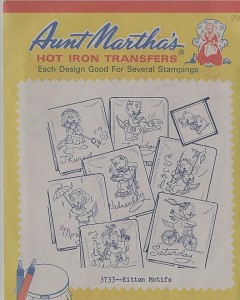 rk, lunch for updating the week and writing projects with Pat, Thursday afternoon is Gallery Calapooia and i have scheduled my weaving time, which always works for me. It allows me to say no and tell all to go away so I can weave and do those things necessary for my weaving. This new schedule should allow me 4-8 hours a day for weaving. Sort of reminds me of my grandmother’s embroidered tea towels with something for everyday. We all knew which day she was doing what.
rk, lunch for updating the week and writing projects with Pat, Thursday afternoon is Gallery Calapooia and i have scheduled my weaving time, which always works for me. It allows me to say no and tell all to go away so I can weave and do those things necessary for my weaving. This new schedule should allow me 4-8 hours a day for weaving. Sort of reminds me of my grandmother’s embroidered tea towels with something for everyday. We all knew which day she was doing what.
I am now at a place to begin my new tapestries-Hallelujah, etc etc. But first- Now is the time when I spend a little- a lot of my thought process analyzing what I think I could have done better or maybe not so much better– as should have/could have done differently. I finished the forever
“7 times 7…” almost dog piece and photographed it in
time for entering the ATA 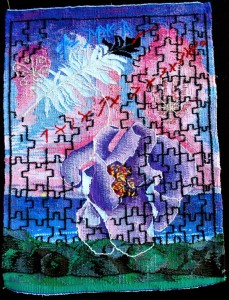 exhibit. I was a very doubtful that i would get it finished and
exhibit. I was a very doubtful that i would get it finished and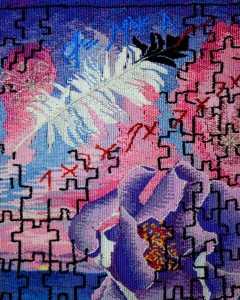 photographed in time. Perhaps doubtful it will even be juried into the show, but I needed a deadline to work towards. I like the design and it’s well woven, but there are things in it’s weft construction I probably won’t do again.
photographed in time. Perhaps doubtful it will even be juried into the show, but I needed a deadline to work towards. I like the design and it’s well woven, but there are things in it’s weft construction I probably won’t do again.
It was almost impossible to get a decent photo because of the high amount of silk and rayon in it. I took the photo’s over 12 times. Let alone the same amount of times or more for the details. My Nikon Color pix couldn’t deal with the silk and weave structure at all. My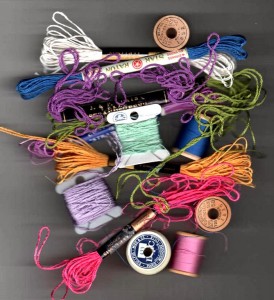 larger Nikon D-60 did slightly better, but had a tendency to darken all of the colours and moiré.They-rayon/silk- have this thing that they do better known as the “moiré effect” that happens with a higher rate of frequency the more silk and rayon that is mixed in with the cottons and embroidery flosses in the weft bundles. This piece seemed to be darker when photographed. I was hoping for lighter and a sheen from the rayon and silk. Didn’t happen!
larger Nikon D-60 did slightly better, but had a tendency to darken all of the colours and moiré.They-rayon/silk- have this thing that they do better known as the “moiré effect” that happens with a higher rate of frequency the more silk and rayon that is mixed in with the cottons and embroidery flosses in the weft bundles. This piece seemed to be darker when photographed. I was hoping for lighter and a sheen from the rayon and silk. Didn’t happen!
One of the things I discovered in this piece is I am not particularly fond of the effect of silk and rayon in the tapestry weave process. At 20 epi the distance over a warp thread to the under the warp thread isn’t large enough to maximize the visual effect that rayon and silk have over a longer distance. Instead of shiny reflection one gets a hard look in some cases an almost straw look. I discovered this also happens when using the thin cut layers of silver used in obis and saganishiki for weaving into tapestry. And ,then ,of course almost worst but in a different way are the moiré pattern that are created digitally when photographed. The bobbins were a nightmare. Always tangling. Handling the weft bundles was best done by not putting them on a bobbin and tying an over hand knot every 8 inches.
(see section below that i wrote on bobbins)
Moiré patterns are often an undesired artifact of images produced by various digital imaging and computer graphics techniques, for example when scanning a halftone picture or ray tracing a checkered plane (the latter being a special case of aliasing, due to under sampling a fine regular pattern).[1] This can be overcome in texture mapping through the use of mip-mapping and anisotropic filtering. |
AND NOW FINALLY THE NEW PIECES!!!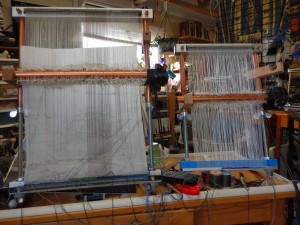 The design is now together and I started w
The design is now together and I started w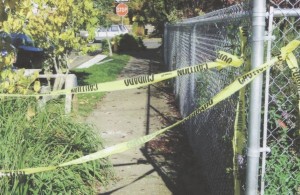 weaving a piece that will be 12 x 12 inches. IT tells’/has a didactic feel and memorializes some thought that I had about my Dad’s life .Perhaps, a narrative about my fathers life. I wanted to use some caution tape, but didn’t have any pieces to work from. Came home one day and found the contractor had tied off th
weaving a piece that will be 12 x 12 inches. IT tells’/has a didactic feel and memorializes some thought that I had about my Dad’s life .Perhaps, a narrative about my fathers life. I wanted to use some caution tape, but didn’t have any pieces to work from. Came home one day and found the contractor had tied off th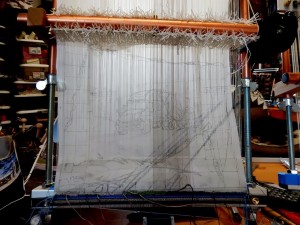 e sid
e sid ewalk to keep people away from the scaffolding they were using while working on the soffits. So I have lots of pictures of draping caution tape.If you look carefully you can see the image of the truck and the caution tape on the cartoon behind he warp.
ewalk to keep people away from the scaffolding they were using while working on the soffits. So I have lots of pictures of draping caution tape.If you look carefully you can see the image of the truck and the caution tape on the cartoon behind he warp.
I am also working on a series of small tapestries. The series is going to be called elements. Most will be about 3 inches x 3 inches and/or 2 x2 inches just be bits and pieces of things I like, but really don’t need to put into a larger tapestry. But, Have Always wanted to weave just for the fun of it. Another reason-not the real reason for doing them-just part of the nagging thought process of why not and what for this series is. Since i have been at Gallery Calapooia i am being asked if I do less expensive pieces for the beginner collector. One of the conclusions i came to while going through my journals is that I have oodles of small drawings, and photos of what i call bits and pieces that I would love the challenge myself with weaving, but never fit in to any particular design. So why not? Just for the shear pleasure and fun of doing or weaving bits and pieces that take smaller amounts of time.
BOBBINS-
On the tapestry list the subject of bobbins circles around about every other year. There’s always the discussion of why use them, why choose specific 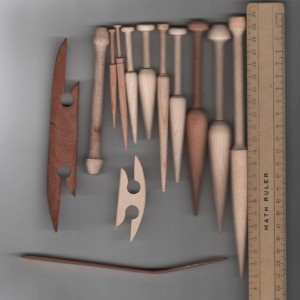 ones , how do you use them, why not needles, are they worth cost,appropriate size, etc, etc, etc.
ones , how do you use them, why not needles, are they worth cost,appropriate size, etc, etc, etc.
SO I thought I would list the reasons, show examples of bobbin shapes and sizes, needles, and a few do’s and probably nots, etc.
reasons for using a bobbin-
When i compile a list such as this, I wish people would understand their are no tapestry police. There’s no right or wrong only what works and what is comfortable to the individual. NO ones going to demand that you stop weaving tapestries just because you don’t do it in a specific way with specific tools and looms.
So here are the reasons I use bobbins–
PRO’s
1 And, let’s get it out of the way. Bobbins ARE not a butterfly or a needle. hallelujah! I am butterfly challenged and hate needles.
2. Bobbins organize weft bundles.
3.Bobbins help keep the weft bundles cleaner. Less likely to pick up oil from the fingers, debris and dust then when weft is long and hanging from the fell line.
4. protects the weft bundle as it is drawn through the warp. Less wear on the weft bundle.
5. In advanced tapestry weaving -it allows you to twist the weft bundle to produce different densities of colour by twisting the weft bundles tighter or looser between the fell line and the bobbin.
6. Saves time.Less chance of tangling yarns and needing to untangle. Unless of course your working with multiple wefts of silk or rayon, which will tighten down on the wrapped threads on a bobbin and tangle in a whole new way when you try to get more weft from the wrapped bundle.
7. Ergonomically easier on the hands then a needle or a butterfly. Your fingers are not grasping and pulling small elements that can hurt the hands over time.
8. Bobbins will not accidentally pierce a warp.
9.Less wear on the weft as great amounts of it are used or pulled through the sheds. Wool and delicate threads will wear, become fuzzy and become less(wear) when pulled or unwoven over and over.
10. Point of the bobbin can be used to place weft, pull down the bubble, 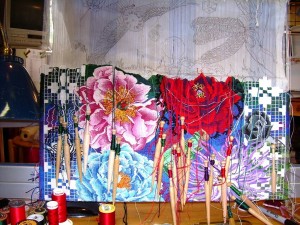 hold a weft in place or move a warp.
hold a weft in place or move a warp.
11. The side of the bobbin can be used to very effectively scrape a weft bundle into place along a fell line.
12 .Bobbins helps control the loopies and unevenness that can occur in weft bundles left hanging and then picked up to be woven.
13. Once you get used to them you can weave faster.
14. Bones-a type of bobbin without a point are less likely to fall through low warp looms and all of the above applies when using bones.
15. Bobbins are faster because you can change the direction with one hand and you only need to use one tool to move the weft along. Instead of several.
16. If you really get into large amounts of thread on a bobbin there are machines that can feel the bobbin-depending on the size of bobbin used. I have found though that my Swedish Bobbins will hold about 1.5 yards of 4-5 strands of wool. More then enough even on my largest pieces that
I have woven on.
17 the smaller the bobbin down to a certain size the faster you can push it through the shed and turn for the next half pass or demi duite.
Cons- 1. The right size for the hand or the loom can be difficult to find-Fine Fiber Press is a good source for different sizes.
2. Tips aren’t meant be used to pry with and can be broken. New tips can be sharpened, use an awl, or get a brassy bob. Expensive, but you really only need one-or two-not all brassy bobs or a small palm awl will also suffice.
3. There usage is a learned skill. AND, people who use needles are often relating back to already learned skills and aren’t interesting in attempting to take the time to learn a new skill. Or, occasionally, in some cases find it easier to manipulate because of lack of strength or other hand issues. I find that using needles exasperates my hand issues.
4. Pointed bobbins don’t work really well on low warp looms-Point falls though easily-use bones or flutes that are meant for low warp looms.
5. Need to learn to use bobbins in a specific way to make them practical-nob always goes through shed first. going point first grabs warps from the other shed.
5. Bobbins can run away. Learn the trick of hitching over the knob and it all stops and you can easily pull the thread off the bobbin for weaving.
HOW DO TELL A GOOD BOBBIN FROM A BAD BOBBIN
.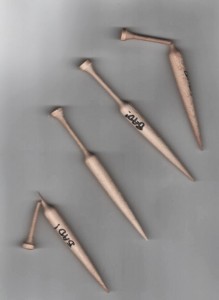
1. Check out where the spindle that the weft will be wrapped around. It needs to have a bit of substance. Yes, those bad bobbins are beautiful and graceful looking, but are not built to function over the long term. Plastic bobbins are cheap, but extremely fragile and not terribly practical over time and most of the tips suck because they are the wrong shape to go between the warps easily and who wants to stay in contact for long hours with plastic. Check where the spindle attaches to the barrel. It has to be attached in such away that it’s not fragile and can stand up to being pulled on and with stand pressure from the fingers.
2 It needs to be hard wood. Soft woods break easily and wear with weaving. Best bets are cherry, oak or maple-all hard woods.
3. If the tip of a bobbin breaks, don’t chuck it repoint with a jack knife or carving knife.
4. Stay away from heavily oiled and treated woods. Remember they will be in contact with your hands and the wefts for long periods of time. Finishes don’t stay on long. They wear off with use.
5. Stay away from endangered rain forest woods. Don’t create a market for the woods. Usually hard woods from the rainforest are dense and heavier then oak, maple or cherry. If a tip breaks they are hard to repoint and save.
6. If someone tells you the bobbins are from recycled woods, ask the person if the woods that were recycled were ever painted or were from marine salvaged wood. Lead based paints and other not so chemicals can be found on recycled woods.Know where those recycled woods came from before you buy.
7. If you are just starting don’t go out and by several dozen bobbins just because those are the ones your instructor used. Buy one of several different sizes until you find the one that works for your hand. Companies such as FFP will allow you to trade them back for the ones that do work for you. Once you’ve found the one that feels good buy them by bulk. Usually there is a substantial discount. Or go in with a friend.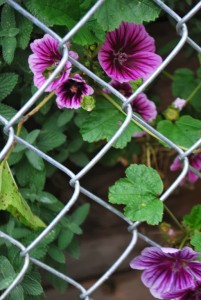 That’s all for now!
That’s all for now!
kathe